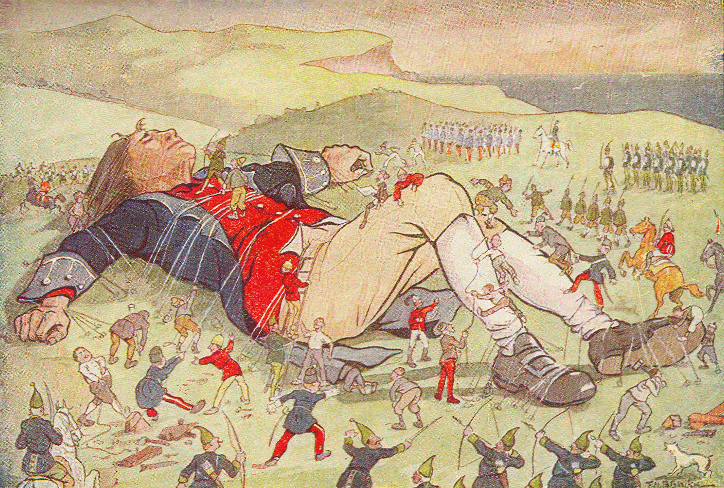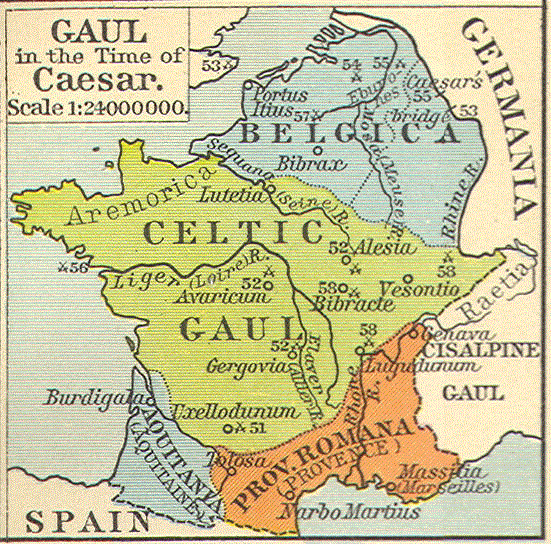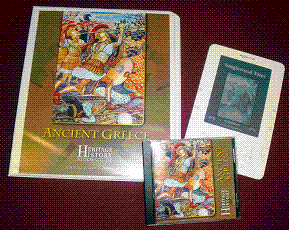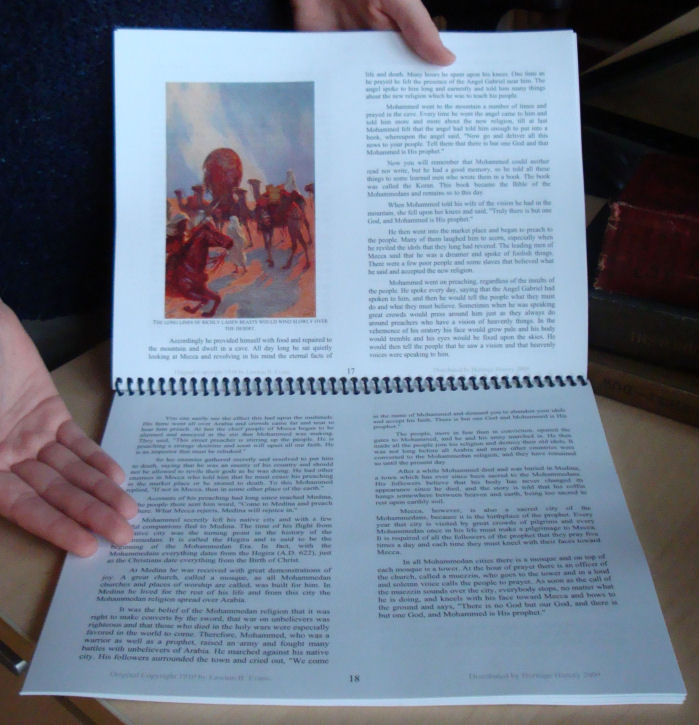Portable
Introductory
Library
Study Aids
Curriculum
Electronic Texts

Welcome to the Heritage Classical Curriculum, Young Readers edition.
If you have never used a Heritage History Compact Library before, this page will
introduce you to the educational resources that are part of the Curriculum
and show how they can be used for independent study.
A Portable Curriculum
The page you are looking at appears to be a website, but it is not. It uses the same
software that you are accustomed to using when you browse the internet, but
instead of going over the network to access data files, it is reading them directly
from the Compact Disc on your computer. Each Heritage Library contains a great deal
of information and the browser software allows us to organize it in a way that is
familiar to most people.
All of the books and other resources that you link to in
this environment are available for you to view, print, or download to another
device. You don't need to pay any additional fees to copy these books to
an e-Reader or Tablet and you don't need to access the internet to view them on
your own computer. Best of all, you don't need to worry about
copyright violations
if you choose to print or copy anything from the Ancient Rome Library
for your personal use.
For those who prefer hardcopies, most of the information presented on this
Compact Library is available in reproducible form. The
Young Readers Teacher's Guide can be printed and reviewed
off line. Likewise, all of the books included in the Young Readers
library contain printable versions and most are less than 50 printed
pages.
It is not necessary to print any of the books since each is
available in e-Reader format as well as printable PDF. For those users who
are not up-to-date regarding the most recent advances in e-Book
technology, the Heritage Curriculum includes an
Electronic Texts User Guide which
provides instructions for downloading books from your Compact Library to
several popular e-Readers. It also includes information about
self-publishing, electronic readers, and copyright issues.
An Introductory Curriculum
The Young Readers collection is the introductory unit of the Heritage
Classical Curriculum. It is intended for grammar school students
who are already reading fluently but are not yet ready to benefit from
a systematic study of Western Civilization. The Young Readers collection
includes easy-to-read introductory selections from most of the
other libraries in the Heritage History collection. None of
the books are comprehensive histories—that is, they are not
intended to give a complete overview of a civilization. Instead,
most focus on only a few historical stories or vignettes that are
of most interest to young readers.
The Young Readers Compact Library represents
a broad and age-appropriate introduction to all of Western
civilization. Primary subjects include American, European,
and Ancient history, Bible and saint stories, legends and literature.
The collection of books touches upon all of the major elements of
Western Civilization, but in a child-friendly, easy-to-understand manner.
All of the books in the Young Readers library can be read by
an older grammar school student, but they are also
appropriate for read-aloud to younger children. And although the
stories are told in simple enough terms for a nine or ten-year-old
to understand, they are engaging enough to be of interest to older
students as well.
The Young Readers library contains more books than most students are
likely to read during their grammar school years. But the wide
range of books available guarantees that every child will find something
that interests them. If the reading recommendations for young readers
are followed, students will certainly be exposed to many of the most
famous characters from American, European, and Ancient history. This
will not be the last word they hear on any of these fascinating subjects,
but it should provide a strong foundation for further study.
The Library
 The centerpiece of the Young Readers Classical Curriculum is its
collection of over eighty classical history-related books written specifically
for young people. All of the books in the Young Readers library are
simple enough for a fourth grader to read on their own, and most are
relatively short. Each is presented in several different file
types, so students can read them on their home computer, make printed
copies, or download them to their e-Reader.
The centerpiece of the Young Readers Classical Curriculum is its
collection of over eighty classical history-related books written specifically
for young people. All of the books in the Young Readers library are
simple enough for a fourth grader to read on their own, and most are
relatively short. Each is presented in several different file
types, so students can read them on their home computer, make printed
copies, or download them to their e-Reader.
Although many of the books in the Young Readers library do a good
job of introducing famous characters and events of world history,
very few can be considered "comprehensive" histories. On the
Recommendations page, we advise instructors to make
sure students read books from a few specific categories in order to
make sure their reading selections cover the basics of the major
historical divisions of Western Civilization. But even those books
we advocate for breadth are historical anecdotes rather than systematic
histories. Other genres included in the collection are
short biographies, Bible stories, legends, simplified literature,
and historical fiction.
In addition to providing book lists organized by
genre and
subject, the
Young Readers Library contains two additional reference pages intended to help
students and instructors identify books of particular interest. The
Book Summaries page includes a short
description of each book in the library. The
Series Descriptions page, which features descriptions of
overall series rather than individual books, may be helpful to those
readers who enjoy a particular book and would like to locate similar volumes.
These reference pages are intended to help students and their instructors
decide which books are of most interest. We recommend that parents or instructors
of younger students familiarize themselves with the whole collection so that
they can help their charges use the library effectively.
Study Aids
 Each Heritage Classical Curriculum includes a Study Aids section which
is intended to provide learning resources which complement the material covered
in the associated library. Since all the curriculums other than
Young Readers focus on one civilization in particular, the associated
study aids typically include maps, timelines, and battle summaries
that pertain to that civilization.
Each Heritage Classical Curriculum includes a Study Aids section which
is intended to provide learning resources which complement the material covered
in the associated library. Since all the curriculums other than
Young Readers focus on one civilization in particular, the associated
study aids typically include maps, timelines, and battle summaries
that pertain to that civilization.
The Study Aids section of the Young Readers Compact Library is organized
somewhat differently.
Because the Young Readers library includes simplified stories from much of
world history, detailed learning resources are not appropriate. The
timeline and
character lists associated with the
collection are therefore very general. On the other hand,
many of the books in the Young Readers collection are beautifully
illustrated, so the
images directory contains an extraordinary
number of vivid color illustrations, including historical, biblical, and
legendary subjects.
Another difference between the Study Aids intended for Young Readers and
those of other curriculums is that a
Teacher's Guide, intended for
instructors of Young Children is included. Since most grammar school
students are too young to work independently it is assumed that their studies
will be guided by a parent or teacher. The Teacher's Guide provides
information, advice, and insights for instructors rather than for students
themselves.
All of the information in the Study Aids section of the Young Readers
Compact Library can be found in printable form in the
Young Readers Teacher's Guide.
We recommend that portions of this document be printed and put in a notebook so that
students can refer to timelines and character lists to get an idea of the
chronology of western history. They can also use the notebook to
keep track of their reading progress, and add other material of interest.
The Curriculum Guide
 he Heritage Classical Curriculum differs from many other
programs not only in the selection of books it uses, but also in
its methods. These differences are set forth in the Introduction
of the
Curriculum User Guide, along with
a discussion of the "living books" approach to history,
and other aspects of the Heritage History learning philosophy.
he Heritage Classical Curriculum differs from many other
programs not only in the selection of books it uses, but also in
its methods. These differences are set forth in the Introduction
of the
Curriculum User Guide, along with
a discussion of the "living books" approach to history,
and other aspects of the Heritage History learning philosophy.
Most of the rest of the User Guide
covers practical rather than philosophical issues. It provides
advice for keeping students on track learning the essentials while maintaining
enough flexibility to allow them to pursue their own interests.
Other topics include a description of available Heritage Curriculums
and Libraries, a discussion
of our recommended sequence of instruction, guidelines
for scheduling reading assignments, and suggestions for oral and written
review.
A printable copy of the Heritage
Curriculum User Guide is available, and we
recommend that anyone who has not used the Heritage Classical Curriculum
read the entire guide before beginning the program. If you still have
questions after reading the Curriculum User Guide, refer to the Curriculum
Frequently Asked Questions.
Electronic Texts
 In order to make our entire library of traditional history books available at an
affordable price, Heritage History provides low-cost versions of all of our
books in both e-Reader and printable formats.
Unfortunately, not all Heritage Curriculum users are up-to-date regarding
the most recent advances in electronic books technology. In order to
help our users make informed decisions about usage and purchases of
electronic readers and desktop publishing tools, we have provided an
Electronic Text User Guide. It is
divided into three main sections that deal with issues related to
electronic readers, self-publishing, and copyright restrictions.
In order to make our entire library of traditional history books available at an
affordable price, Heritage History provides low-cost versions of all of our
books in both e-Reader and printable formats.
Unfortunately, not all Heritage Curriculum users are up-to-date regarding
the most recent advances in electronic books technology. In order to
help our users make informed decisions about usage and purchases of
electronic readers and desktop publishing tools, we have provided an
Electronic Text User Guide. It is
divided into three main sections that deal with issues related to
electronic readers, self-publishing, and copyright restrictions.
The Heritage guide to
Electronic Readers discusses the differences
between various e-Reader technologies and gives detailed
instructions for downloading Heritage e-Books from a Compact Library
to an e-Reader device such as Kindle or Apple iPad.
For those who prefer reading hard-copies rather than e-Books, the Heritage guide to
Self-publishing provides tips for printing
and binding the books from the Heritage library at home in an efficient and cost-effective
manner. Finally, the terms and conditions of using the electronic texts are
discussed in the
Copyright Terms section.
A printable copy of the Heritage
Electronic Texts User Guide is available,
and we strongly
recommend that anyone who is not already familiar with e-Reader technology,
laser printers, and binding equipment read the guide before deciding
how to use the Heritage e-Book library. Even technologically advanced readers
should familiarize themselves with the copyright
status of the Heritage books before beginning the program. If you still have
questions after reading the Electronic Text User Guide, refer to the Electronic Texts
Frequently Asked Questions.





